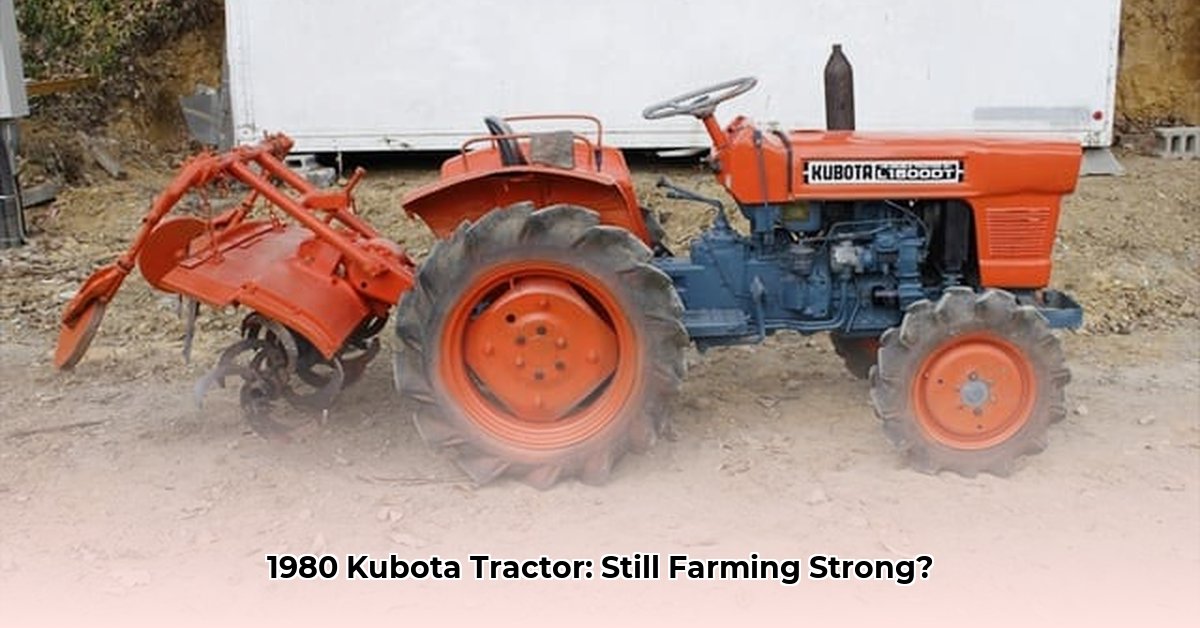
A Legacy of Compact Power: The 1980 Kubota and its Role in Sustainable Agriculture
The 1980s witnessed a quiet revolution in agriculture: the rise of compact tractors. Smaller farms, previously reliant on larger, less maneuverable equipment, found a new ally in these efficient machines. This article examines the 1980 Kubota tractor, exploring its technical specifications, comparing it to its predecessors and successors, and assessing its impact—within the limitations of available historical data—on sustainable farming practices. For more information on Kubota attachments, see this helpful resource.
Technical Specifications of a 1980 Kubota Tractor: A General Overview
Precise specifications for individual 1980 Kubota models remain elusive due to limited archival data. However, based on common features of Kubota tractors from this era, a general profile can be constructed:
- Engine: Most likely a diesel engine, common for its power and efficiency in agricultural applications. Horsepower likely ranged from 15 to 30 hp, depending on the specific model. (Diesel engines: Internal combustion engines that utilize diesel fuel, known for their durability and fuel efficiency.)
- Transmission: Manual gearboxes were standard. These offered the operator greater control over the tractor's speed and power delivery but demanded more skill than more modern automatic transmissions.
- Power Take-Off (PTO): A PTO shaft, typically rotating at 540 RPM (revolutions per minute), provided power to various implements, such as tillers, mowers, and balers. (PTO: A mechanical system that transfers power from the tractor's engine to external implements.)
- Hydraulic System: Likely a simpler, single-pump hydraulic system compared to the more complex, multi-function systems found in modern tractors. This system provided the necessary power for lifting implements and other functions.
- Three-Point Hitch: This essential attachment system allowed the tractor to connect with various implements, enhancing its versatility.
Did the relatively simple design of the 1980 Kubota contribute to its long-term durability and ease of maintenance?
Comparative Analysis: Technological Advancements in Kubota Tractors
Compared to earlier Kubota models, the 1980 versions showed improvements in power and features, yet fell short of later innovations. Earlier models were smaller, less powerful, and had fewer sophisticated features. Later models boasted increased horsepower, more advanced hydraulic systems (capable of controlling multiple implements simultaneously), and significantly, the transition to hydrostatic transmissions (HST), providing automatic shifting and smoother operation.
Sustainability Considerations: A Historical Perspective
Evaluating the 1980 Kubota's environmental impact is challenging due to the lack of comprehensive emissions data from that era. While modern sustainability standards emphasize low emissions and efficient fuel consumption, the data required to make a rigorous assessment is missing. Diesel engines of the time likely emitted higher levels of pollutants compared to modern, cleaner counterparts. Moreover, manufacturing processes were less environmentally conscious than those employed today. The absence of detailed historical data highlights the crucial need for comprehensive record-keeping in assessing the long-term environmental performance of agricultural machinery. How can we accurately assess the lifecycle environmental impact of these machines without this essential data?
Conclusion: A Significant Step in Agricultural Mechanization
Despite limited data on its environmental performance, the 1980 Kubota represents a notable stride in the evolution of agricultural machinery toward increased efficiency and sustainability for its time. Its compact size, reliability, and adaptability revolutionized farming, particularly for smaller operations. While contemporary tractors surpass it in efficiency and environmental friendliness, the 1980 Kubota played a vital role, leaving a lasting impression on the landscape of farming practices. Future research, leveraging advanced data analysis techniques and potentially uncovering additional historical records, could further refine our understanding of the tractor's full environmental footprint.